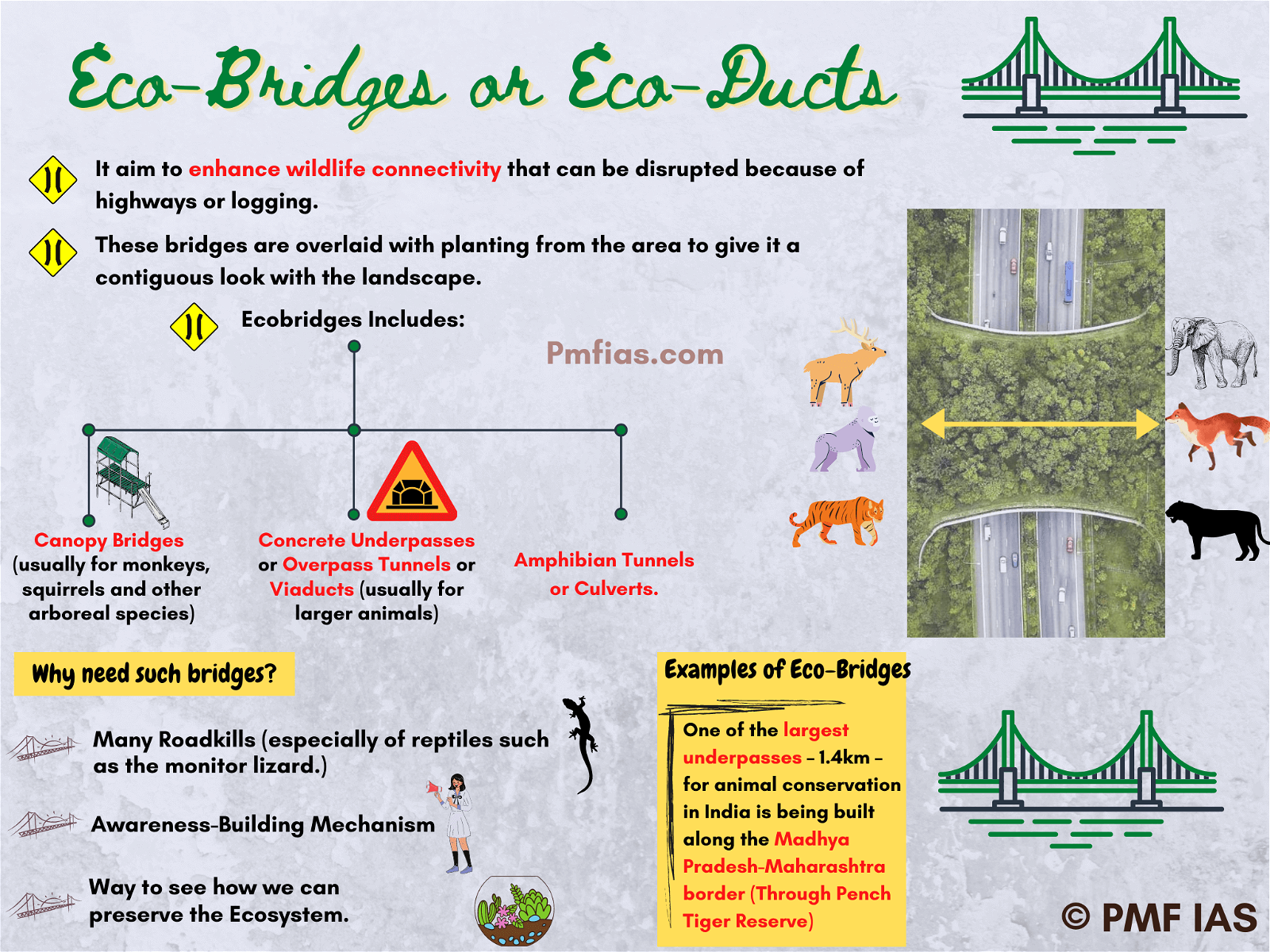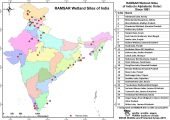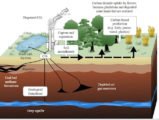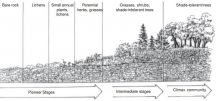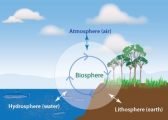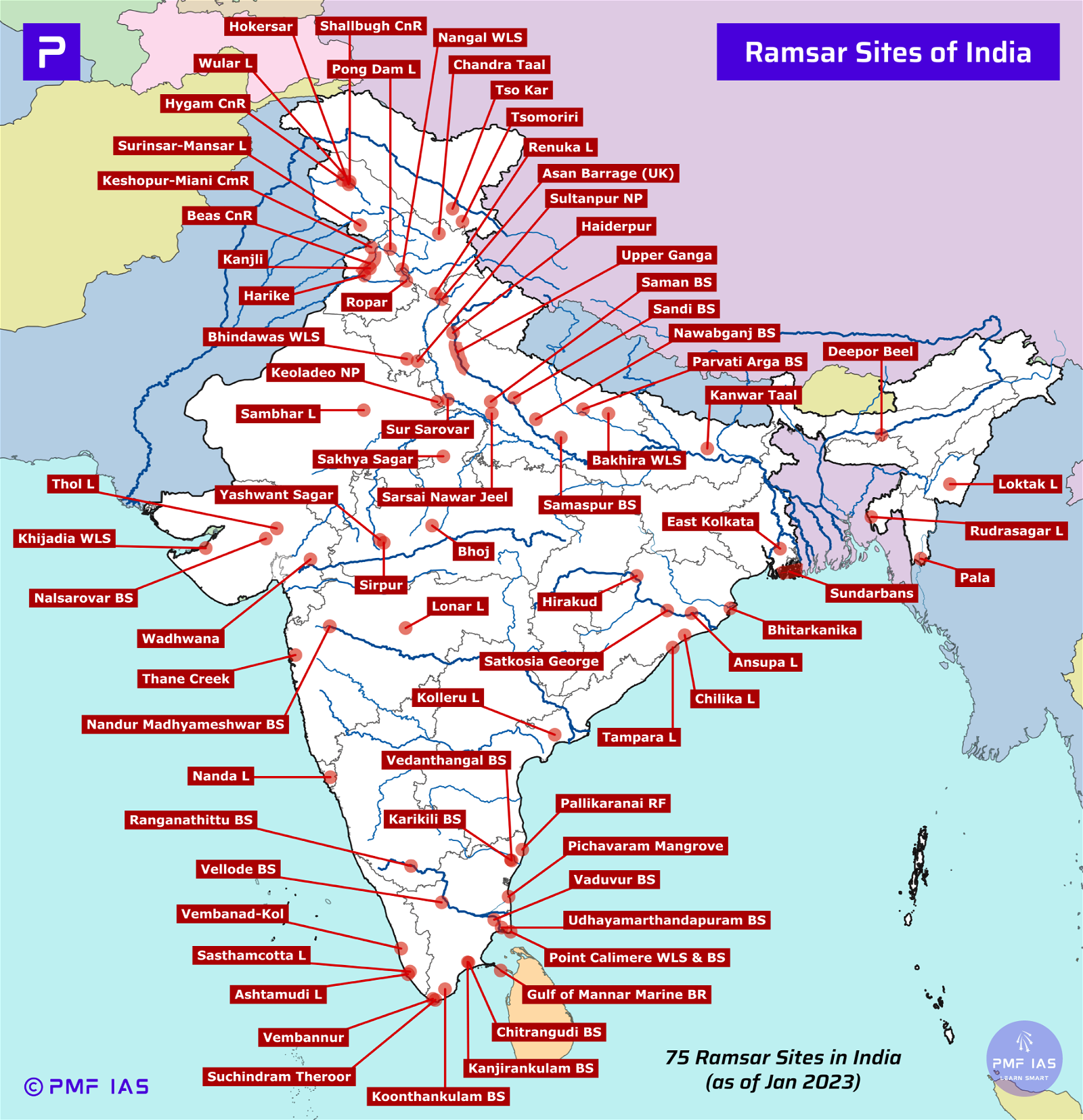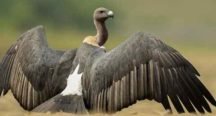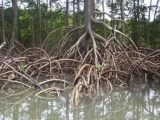
Environment Questions Asked in Prelims & Mains (2011-15)
Subscribe to Never Miss an Important Update! Assured Discounts on New Products!
Must Join PMF IAS Telegram Channel & PMF IAS History Telegram Channel
Prelims Questions From Previous Papers
- The questions from the previous 3-4 years’ prelims papers help us understand the nature of questions asked in prelims and the trend the UPSC is following.
- Don’t worry about the answers. Answer for each question with explanation is given under respective topics.
- Next post will have all the solved prelims questions with explanation.
- Environment is the high priority topic for prelims and can be studied in relatively less hours compared to other subjects [Very High Cost to Benefit Ration].
I advise you to first go through the full notes before trying to understand these question.
2011-2012
Q1. Which one of the following is not a site for in-situ method of conservation of flora?
- Biosphere Reserves
- Botanical Garden
- National Park
- Wildlife Sanctuary
Q2. What is the difference between the antelopes Oryx and Chiru?
- Oryx is adapted to live in hot and arid areas whereas Chiru is adapted to live in steppes and semi-desert areas of cold high mountains. .
- Oryx is poached for its antlers whereas Chiru is poached for its musk.
- Oryx exists in western India only whereas Chiru exists in north-east India only.
- None of the statements a, b, and c given above is correct.
Q3. Among the following States, which one has the most suitable climatic conditions for the cultivation of a large variety of orchids with minimum cost of production, and can develop an export oriented industry in this field ?
- Andhra Pradesh
- Arunachal Pradesh
- Madhya Pradesh
- Uttar Pradesh
Q4. Consider the following:
- Black-necked crane
- Cheetah
- Flying squirrel
- Snow leopard
Which of the above are naturally found in India ?
- 1, 2 and 3 only
- 1, 3 and 4 only
- 2 and 4 only
- 1, 2, 3 and 4
Q5. A sandy and saline area is the natural habitat of an Indian animal species. The animal has no predators in that area but its existence is threatened due to the destruction of its habitat. Which one of the following could be that animal?
- Indian wild buffalo
- Indian wild ass
- Indian wild boar
- Indian Gazelle
Q6. Consider the following kinds of organisms
- Bat
- Bee
- Bird
Which of the above is/are pollinating agent/agents?
- 1 and 2 only
- 2 only
- 1 and 3 only
- 1, 2 and 3
Q7. The ‘Red Data Books’ published by the International Union for Conservation of Nature and Natural Resources (IUCN) contain lists of
- Endemic plant and animal species present in the biodiversity hotspots.
- Threatened plant and animal species.
- Protected sites for conservation of nature & natural resources in various countries.
Which of the statement given above is/are correct ?
- 1 & 3
- 2 only
- 2 & 3
- 3 only
Q8. Which one of the following groups of animals belongs to the category of endangered species?
- Great Indian Bustard, Musk Deer, Red Panda and Asiatic Wild Ass
- Kashmir Stag, Cheetal, Blue Bull and Great Indian Bustard
- Snow Leopard, Swamp Deer, Rhesus Monkey and Saras (Crane)
- Lion-tailed Macaque, Blue Bull, Hanuman Langur and Cheetal
Q9. The Himalayan Range is very rich in species diversity. Which one among the following is the most appropriate reason for this phenomenon?
- It has a high rainfall that supports luxuriant vegetative growth.
- It is a confluence of different bio geographical zones.
- Exotic and invasive species have not been introduced in this region.
- It has less human interference.
Q10. If a tropical rain forest is removed, it does not regenerate quickly as compared to a tropical deciduous forest. This is because
- the soil of rain forest is deficient in nutrients
- propagules of the trees in a rain forest have poor viability
- the rain forest species are slow-growing
- exotic species invade the fertile soil of rain forest.
Q11. When the bark of a tree is removed in a circular fashion all around near its base, it generally dries up and dies because
- Water from soil cannot rise to aerial parts.
- Roots are starved of energy
- Tree is infected by soil microbes
- Roots do not receive oxygen for respiration
Q12. Consider the following:
- Photosynthesis
- Respiration
- Decay of organic matter
- Volcanic action
Which of the above add carbon dioxide to the carbon cycle on Earth ?
- 1 and 4 only
- 2 and 3 only
- 2,3 and 4 only
- 1, 2, 3 and 4
Q13. Consider the following statements: Chlorofluorocarbons, known as ozone-depleting substances, are used
- in the production of plastic foams
- in the production of tubeless tyres
- in cleaning certain electronic components
- as pressurizing agents in aerosol cans
Which of the statements given above is/are correct?
- 1, 2 and 3 only
- 4 only
- 1, 3 and 4 only
- 1, 2, 3 and 4
Q14. Consider the following:
- Carbon dioxide
- Oxides of Nitrogen
- Oxides of Sulphur
Which of the above is/are the emission / emissions from coal combustion at thermal power plants ?
- 1 only
- 2 and 3 only
- 1 and 3 only
- 1, 2 and 3
Q15. The increasing amount of carbon dioxide in the air is slowly raising the temperature of the atmosphere, because it absorbs
- the water vapour of the air and retains its heat.
- the ultraviolet part of the solar radiation.
- all the solar radiations.
- the infrared part of the solar radiation
Q16. The formation of ozone hole in the Antarctic region has been a cause of concern. What could be the reason for the formation of this hole?
- Presence of prominent tropospheric turbulence; and inflow of chlorofluorocarbons
- Presence of prominent polar front and stratospheric clouds; and inflow of chloro fluorocarbons
- Absence of polar front and stratospheric clouds; and inflow of methane and chloro fluorocarbons.
- Increased temperature at polar region due to global warming
Q17. The acidification of oceans is increasing. Why is this phenomenon a cause of concern?
- The growth and survival of calcareous phytoplankton will be adversely affected.
- The growth and survival of coral reefs will be adversely affected.
- The survival of some animals that have phytoplanktonic larvae will be adversely affected.
- The cloud seeding and formation of clouds will be adversely affected.
Which of statements given above is / are correct?
- 1, 2 and 3 only
- 2 only
- 1 and 3 only
- 1, 2, 3 and 4
Q18. Regarding “carbon credits”, which one of the following statements is not correct?
- The carbon credit system was ratified in conjunction with the Kyoto Protocol
- Carbon credits are awarded to countries or groups that have reduced greenhouse gases below their emission quota
- The goal of the carbon credit system is to limit the increase of carbon emission quota
- Carbon credits are traded at a price fixed from time to time by the United Nations Environment Programme.
Q19. With reference to India, consider the following Central Acts:
- Import and Export (Control) Act, 1947.
- Mining and Mineral Development (Regulation) Act, 1957
- Customs Act, 1962
- Indian Forest Act, 1927
Which of above Acts have relevance to/bearing on the biodiversity conservation in the country ?
- 1 and 3 only
- 2,3 and 4 only
- 1,2,3 and 4
- None of the above Acts
Q20. The National Green Tribunal Act, 2010 was enacted in consonance with which of the following provisions of the Constitution of India?
- Right to healthy environment, construed as a part of part of Right to life under Article 21.
- Provision of grants for raising the level of administration in the Scheduled Areas for the welfare of Scheduled Tribes under Article 275(1)
Which of the statements given above is/are correct ?
- 1 only
- 2 only
- Both 1 and 2
- Neither 1 nor 2
Q21. How does National Biodiversity Authority (NBA) help in protecting the Indian agriculture?
- NBA checks the biopiracy and protects the indigenous and traditional genetic resources.
- NBA directly monitors and supervises the scientific research on genetic modification of crop plants.
- Application for intellectual Property Rights related to genetic / biological resources cannot be made without the approval of NBA.
Which of the statements given above is/are correct?
- 1 only
- 2 and 3 only
- 1 and 3 only
- 1, 2 and 3
Q22. Recently, ‘oilzappee’ was in the news. What is it?
- It is an eco-friendly technology for the remediation of oil sludge and oil spills.
- It is the latest technology developed for under- sea oil exploration.
- It is a genetically engineered high biofuel yielding maize variety.
- It is the latest technology to control the accidentally caused flames from oil wells.
Q23. Government of India encourages the cultivation of ‘sea buckthorn’. What is the importance of this plant ?
- It helps in controlling soil erosion and in preventing desertification.
- It is a rich source of biodiesel.
- It has nutritional value and is well-adapted to live in cold areas of high altitudes.
- Its timber is of great commercial value.
Q24. Two important rivers – one with its source in Jharkhand (and known by a different name in Odisha), and another, with its source in Odisha – merge at a place only a short distance from the coast of Bay of Bengal before flowing into the sea. This is an important site of wildlife and bio-diversity and a protected area. Which one of the following could be this ?
- Bhitarkanika
- Chandipur-on-sea
- Gopalpur-on-sea
- Simlipal
Q25. A particular State in India has the following characteristics:
- It is located on the same latitude which passes through northern Rajasthan.
- It has over 80% of its area under forest cover.
- Over 12% of forest cover constitutes Protected Area Network in this State.
Which one among the following States has all the above characteristics?
- Arunachal Pradesh
- Assam
- Himachal Pradesh
- Uttarakhand
2013
Q1. Consider the following pairs:
- Nokrek Bio-sphere Reserve : Garo Hills
- Logtak (Loktak) Lake : Barail Range
- Namdapha National Park : Dafla Hills
Which of the above pairs is/are correctly matched?
- 1 only
- 2 and 3 only
- 1, 2 and 3
- None
Q2. Consider the following pairs about parks and rivers passing through them:
- Corbett National Park: Ganga
- Kaziranga National Park: Manas
- Silent Valley National Park: Kaveri
Which of the above pairs is/are correctly matched?
- 1 and 2
- 3 only
- 1 and 3
- None
Q3. In which of the following States is lion-tailed macaque found in its natural habitat?
- Tamil Nadu
- Kerala
- Karnataka
- Andhra Pradesh
Select the correct answer using the codes given below.
- 1, 2 and 3 only
- 2 only
- 1, 3 and 4 only
- 1, 2, 3 and 4
Q4. Which of the following is/are unique characteristic/characteristics of equatorial forests?
- Presence of tall, closely set trees with crowns forming a continuous canopy
- Coexistence of a large number of species
- Presence of numerous varieties of epiphytes
Select the correct answer using the code given below:
- 1 only
- 2 and 3 only
- 1 and 3 only
- 1, 2 and 3
Q5. Consider the following fauna of India:
- Gharial
- Leatherback turtle
- Swamp deer
Which of the above is/are endangered?
- 1 and 2 only
- 3 only
- 1, 2 and 3
- None
Q6. Consider the following
- Star tortoise
- Monitor lizard
- Pygmy hog
- Spider monkey
Which of the above found in India?
- 1, 2 and 3 only
- 2 and 3 only
- 1 and 4 only
- 1, 2, 3 and 4
Q7. Consider the following animals:
- Sea cow
- Sea horse
- Sea lion
Which of the above is/are mammal/mammals?
- 1 only
- 1 and 3 only
- 2 and 3 only
- 1, 2 and 3
Q8. Mycorrhizal biotechnology has been used in rehabilitating degraded sites because mycorrhiza enables the plants to
- resist drought and increase absorptive area
- tolerate extremes of pH
- Resist disease infestation
Select the correct answer using the codes given below:
- 1 only
- 2 and 3 only
- 1 and 3 only
- 1, 2 and 3
Q9. Consider the following organisms
- Agaricus
- Nostoc
- Spirogyra
Which of the above is / are used as biofertilizer / biofertilizers
- 1 and 2
- 2 only
- 2 and 3
- 3 only
Q10. Which of the following adds/add nitrogen to the soil?
- Excretion of urea by animals
- Burning of coal by man
- Death of vegetation
Select the correct answer using the codes given below.
- 1 only
- 2 and 3 only
- 1 and 3 only
- 1, 2 and 3
Q11. Contour bunding is a method of soil conservation used in
- desert margins, liable to strong wind action
- low flat plains, close to stream courses, liable to flooding
- scrublands, liable to spread of weed growth
- None of the above
Q12. With reference to the usefulness of the by-products of sugar industry, which of the following statements is / are correct?
- Bagasse can be used as biomass fuel for the generation of energy.
- Molasses can be used as one of the feedstocks for the production of synthetic chemical fertilizers.
- Molasses can be used for the production of ethanol.
Select the correct answer using the codes given below.
- 1 only
- 2 and 3 only
- 1 and 3 only
- 1, 2 and 3
Q13. Due to improper / indiscriminate disposal of old and used computers or their parts, which of the following are released into the environment as e-waste?
- Beryllium
- Cadmium
- Chromium
- Heptachlor
- Mercury
- Lead
- Plutonium
Select the correct answer using the codes given below.
- 1, 3, 4, 6 and 7 only
- 1, 2, 3, 5 and 6 only
- 2, 4, 5 and 7 only
- 1, 2, 3, 4, 5, 6 and 7
Q14. Which of the following can be found as pollutants in the drinking water in some parts of India?
- Arsenic
- Sorbitol
- Fluoride
- Formaldehyde
- Uranium
Select the correct answer using the codes given below.
- 1 and 3 only
- 2, 4 and 5 only
- 1, 3 and 5 only
- 1, 2, 3, 4 and 5
Q15. Which one among the following industries is the maximum consumer of water in India?
- Engineering
- Paper and pulp
- Textiles
- Thermal power
Q16. Acid rain is caused by the pollution of environment by
- carbon dioxide and nitrogen
- carbon monoxide and carbon dioxide
- ozone and carbon dioxide
- nitrous oxide and sulphur dioxide
Q17. Photochemical smog is a resultant of the reaction among
- NO2, 03 and peroxyacetyl nitrate in the presence of sunlight
- CO, 02 and peroxyacetyl nitrate in the presence of sunlight
- CO, CO2 and N02 at low temperature
- High concentration of N02, O3 and CO in the evening
Q18. With reference to food chains in ecosystems, consider the following statements:
- A food chain illustrates the order in which a chain of organisms feed upon each other.
- Food chains are found within the populations of a species.
- A food chain illustrates the numbers of each organism which are eaten by others.
Which of the statements given above is / are correct?
- 1 only
- 1 and 2 only
- 1, 2 and 3
- None
Q19. Which one of the following terms describes not only the physical space occupied by an organism, but also its functional role in the community of organisms?
- Ecotone
- Ecological niche
- Habitat
- Home range
Q20. With reference to the food chains in ecosystems, which of the following kinds of organism is / are known as decomposer organism/organisms?
- Virus
- Fungi
- Bacteria
Select the correct answer using the codes given below.
- 1 only
- 2 and 3 only
- 1 and 3 only
- 1, 2 and 3
Q21. In the grasslands, trees do not replace the grasses as a part of an ecological succession because of
- insects and fungi
- limited sunlight and paucity of nutrients
- water limits and fire
- None of the above
Q22. Which one of the following is the correct sequence of ecosystems in the order of decreasing productivity?
- Oceans, lakes, grasslands, mangroves
- Mangroves, oceans, grasslands, lakes
- Mangroves, grasslands, lakes, oceans
- Oceans, mangroves, lakes, grasslands
2014
Q1. Which one of the following is the process involved in photosynthesis?
- Potential energy is released to form free energy
- Free energy is converted into potential energy and stored
- Food is oxidized to release carbon dioxide and water
- Oxygen is taken, and carbon dioxide and water vapour are given out
Q2. Which of the following adds/add carbon dioxide to the carbon cycle on the planet Earth?
- Volcanic action
- Respiration
- Photosynthesis
- Decay of organic matter
Select the correct answer using the code given below.
- 1 and 3 only
- 2 only
- 1, 2 and 4 only
- 1, 2, 3 and 4
Q3. In India, the problem of soil erosion is associated with which of the following?
- Terrace cultivation
- Deforestation
- Tropical climate
Select the correct answer using the code given below.
- 1 and 2 only
- 2 only
- 1 and 3 only
- 1, 2 and 3
Q4. Lichens, which are capable of initiating ecological succession even on a bare rock, are actually a symbiotic association of
- algae and bacteria
- algae and fungi
- bacteria and fungi
- fungi and mosses
Q5. The most important strategy for the conservation of biodiversity together with traditional human life is the establishment of
- biosphere reserves
- botanical gardens
- national parks
- wildlife sanctuaries
Q6. With reference to ‘Eco-Sensitive Zones’, which of the following statements is/are correct?
- Eco-Sensitive Zones are the areas that are declared under the Wildlife (Protection) Act, 1972.
- The purpose of the declaration of Eco-Sensitive Zones is to prohibit all kinds of human activities, in those zones except agriculture.
Select the correct answer using the code given below.
- 1 only
- 2 only
- Both 1 and 2
- Neither 1 nor 2
Q7. Consider the following pairs
- Dampa Tiger Reserve : Mizoram
- Gumti Wildlife Sanctuary : Sikkim
- Saramati Peak : Nagaland
Which of the above pairs is /are correctly matched?
- 1 only
- 2 and 3 only
- 1 and 3 only
- 1, 2 and 3
Q8. Consider the following pairs
Wetlands Confluence of rivers
- Harike Wetlands Beas and Satluj/Sutlej
- Keoladeo Ghana National Park Banas and Chambal
- Kolleru Lake Confluence of Musi and Krishna
Which of the above pairs is/are correctly matched?
- 1 only
- 2 and 3 only
- 1 and 3 only
- 1, 2 and 3
Q9. Which of the following have coral reefs?
- Andaman and Nicobar Islands
- Gulf of Kutch
- Gulf of Mannar
- Sunderbans
Select the correct answer using the code given below.
- 1, 2 and 3 only
- 2 and 4 only
- 1 and 3 only
- 1, 2, 3 and 4
Q10. Consider the following:
- Bats
- Bears
- Rodents
The phenomenon of hibernation can be observed in which of the above kinds of animals?
- 1 and 2 only
- 2 only
- 1, 2 and 3
- Hibernation cannot be observed in any of the above
Q11. Among the following organisms, which one does not belong to the class of other three?
- Crab
- Mite
- Scorpion
- Spider
Q12. Which one of the following is the correct sequence of a food chain?
- Diatoms-Crustaceans-Herrings
- Crustaceans-Diatoms-Herrings
- Diatoms-Herrings-Crustaceans
- Crustaceans-Herrings-Diatoms
Q13. If you travel through the Himalayas, you are Likely to see which of the following plants naturally growing there?
- Oak
- Rhododendron
- Sandalwood
Select the correct answer using the code given below
- 1 and 2 only
- 3 only
- 1 and 3 only
- 1, 2 and 3
Q14. If you walk through countryside, you are likely to see some birds stalking alongside the cattle to seize the insects, disturbed by their movement through grasses, Which of the following is/are such bird/birds?
- Painted Stork
- Common Myna
- Black-necked Crane
Select the correct answer using the code given below.
- 1 and 2
- 2 only
- 2 and 3
- 3 only
Q15. Other than poaching, what are the possible reasons for the decline in the population of Ganges River Dolphins?
- Construction of dams and barrages on rivers
- Increase in the population of crocodiles in rivers
- Getting trapped in fishing nets accidentally
- Use of synthetic fertilizers and other agricultural chemicals in crop-fields in the vicinity of rivers
Select the correct answer using the code given below.
- 1 and 2 only
- 2 and 3 only
- 1, 3 and 4 only
- 1, 2, 3 and 4
Q16. With reference to two non-conventional energy sources called ‘coal bed methane’ and ‘shale gas’, consider the following ‘statements:
- Coal bed methane is the pure methane gas extracted from coal seams, while shale gas is a mixture of propane and butane only that can be extracted from fine-grained sedimentary rocks.
- In India abundant coal bed methane sources exist, but so far no shale gas sources have been found.
Which of the statements given above is/are correct?
- 1 only
- 2 only
- Both 1 and 2
- Neither 1 nor 2
Q17. In India, cluster bean (Guar) is traditionally used as a vegetable or animal feed, but recently the cultivation of this has assumed significance. Which one of the following statements is correct in this context?
- The oil extracted from seeds is used in the manufacture of biodegradable plastics
- The gum made from its seeds is used in the extraction of shale gas
- The leaf extract of this plant has the properties of anti-histamines
- It is a source of high quality biodiesel
Q18. With reference to technologies for solar power production, consider the following statements:
- ‘Photovoltaics’ is a technology that generates electricity by direct conversion of light into electricity, while ‘Solar Thermal’ is a technology that utilizes the Sun’s rays to generate heat which is further used in electricity generation process.
- Photovoltaics generates Alternating Current (AC), while Solar Thermal generates Direct Current (DC).
- India has manufacturing base for Solar Thermal technology, but not for Photovoltaics.
Which of the statements given above is / are correct?
- 1 only
- 2 and 3 only
- 1, 2 and 3
- None
Q19. There is some concern regarding the nanoparticles of some chemical elements that are used by the industry in the manufacture of various products. Why?
- They can accumulate in the environment, and contaminate water and soil.
- They can enter the food chains.
- They can trigger the production of free radicals.
Select the correct answer using the code given below.
- 1 and 2 only
- 3 only
- 1 and 3 only
- 1, 2 and 3
Q20. Which of the following are some important pollutants released by steel industry in India?
- Oxides of sulphur
- Oxides of nitrogen
- Carbon monoxide
- Carbon dioxide
Select the correct answer using the code given below.
- 1, 3 and 4 only
- 2 and 3 only
- 1 and 4 only
- 1,2, 3 and 4
Q21. Brominated flame retardants are used in many household products like mattresses and upholstery. Why is there some concern about their use?
- They are highly resistant to degradation in the environment.
- They are able to accumulate in humans and animals.
Select the correct answer using the code given below.
- 1 only
- 2 only
- Both 1 and 2
- Neither 1 nor 2
Q22. Consider the following countries:
- Denmark
- Japan
- Russian Federation
- United Kingdom
- United States of America
Which of the above are the members of the ‘Arctic Council ‘?
- 1, 2 and 3
- 2, 3 and 4
- 1, 4 and 5
- 1, 3 and 5
Q23. With reference to ‘Global Environment Facility’, which of the following statements is/are correct?
- It serves as financial mechanism for ‘Convention on Biological Diversity’ and ‘United Nations Framework Convention on Climate Change’.
- It undertakes scientific research on environmental issues at global level
- It is an agency under OECD to facilitate the transfer of technology and funds to underdeveloped countries with specific aim to protect their environment.
- Both (a) and (b)
Q24. If a wetland of international importance is brought under the ‘Montreux Record’, what does it imply?
- Changes in ecological character have occurred, are occurring or are likely to occur in the wetland as a result of human interference.
- The country in which the wetland is located should enact a law to prohibit any human activity within five kilo meters from the edge of the wetland
- The survival of the wetland depends on the cultural practices and traditions of certain communities living in its vicinity and therefore the cultural diversity therein should not be destroyed
- It is given the status of ‘World Heritage Site’
Q25. With reference to a conservation organization called Wetlands International’, which of the following statements is/are correct?
- It is an intergovernmental organization formed by the countries which are signatories to Ramsar Convention.
- It works at the field level to develop and mobilize knowledge, and use the practical experience to advocate for better policies.
Select the correct answer using the code given below.
- 1 only
- 2 only
- Both 1 and 2
- Neither 1 nor 2
Q26. Consider the following international agreements:
- The International Treaty on Plant Genetic Resources for Food and Agriculture
- The United Nations Convention to Combat Desertification
- The World Heritage Convention
Which of the above has / have a bearing on the biodiversity?
- 1 and 2 only
- 3 only,
- 1 and 3 only
- 1, 2. and 3
Q27. The scientific view is that the increase in global temperature should not exceed 2 °C above pre-industrial level. If the global temperature increases beyond 3°C above the pre-industrial level, what can be its possible impact/impacts on the world?
- Terrestrial biosphere tends toward a net carbon source
- Widespread coral mortality will occur.
- All the global wetlands will permanently disappear.
- Cultivation of cereals will not be possible anywhere in the world.
Select the correct answer using the code given below.
- 1 only
- 1 and 2 only
- 2, 3 and 4 only
- 1, 2, 3 and 4
Q28. Consider the following statements:
- Animal Welfare Board of India is established under the Environment (Protection) Act, 1986.
- National Tiger Conservation Authority is a statutory body.
- National Ganga River Basin Authority is chaired by the Prime Minister.
Which of the statements given above is/ are correct?
- 1 only
- 2 and 3 only
- 2 only
- 1, 2 and 3
Q29. With reference to Bombay Natural History Society (BNHS), consider the following statements :
- It is an autonomous organization under the Ministry of Environment and Forests.
- It strives to conserve nature through action-based research, education and public awareness.
- It organizes and conducts nature trails and camps for the general public.
Which of the statements given above is/are correct?
- 1 and 3 only
- 2 only
- 2 and 3 only
- 1, 2 and 3
Q30. Consider the following statements regarding ‘Earth Hour’
- It is an initiative of UNEP and UNESCO.
- It is a movement in which the participants switch off the lights for one hour on a certain day every year.
- It is a movement to raise the awareness about the climate change and the need to save the planet.
Which of the statements given above is / are correct?
- 1 and 3 only
- 2 only
- 2 and 3 only.
- 1, 2 and 3
Q31. Every year, a month long ecologically important campaign/festival is held during which certain communities/ tribes plant saplings of fruit-bearing trees. Which of the following are such communities/tribes?
- Bhutia and Lepcha
- Gond and Korku
- lrula and Toda
- Sahariya and Agariya
2015
Q1. Which of the following National Parks is unique in being a swamp with floating vegetation that supports a rich biodiversity?
- Bhitarkanika National Park
- Keibul Lamjao National Park
- Keoladeo Ghana National park
- Sultanpur National park
Q2. What can be the impact of excessive/inappropriate use of nitrogenous fertilizers in agriculture?
- Proliferation of nitrogen-fixing microorganisms in soil can occur.
- Increase in the acidity of soil can take place
- Leaching of nitrate to the ground-water can occur.
Select the correct answer using the code given below.
- 1 and 3 only
- 2 only
- 2 and 3 only
- 1,2 and 3
Q3. With reference to the International Union for Conservation of Nature and Natural Resources (IUCN) and the Convention on International Trade in Endangered Species of Wild Fauna and Flora (CITES), which of the following statements is/are correct?
- IUCN is an organ of the United Nations and CITES is an international agreement between governments
- IUCN runs thousands of field projects around the world to better manage natural environments.
- CITES is legally binding on the States that have joined it, but this Convention does not take the place of national laws.
Select the correct using the code given below.
- 1 only
- 2 and 3 only
- 1 and 3 only
- 1, 2 and 3
Q4. With reference to ‘fly ash’ produced by the power plants using the coal as fuel, which of the following statements is/are correct?
- Fly ash can be used in the production of bricks for building construction
- Fly ash can be used as a replacement for some of the Portland cement contents of concrete
- Fly ash is made up of silicon dioxide and calcium oxide only, and does not contain any toxic elements.
Select the correct answer using the code given below
- 1 and 2
- 2 only
- 1 and 3
- 3 only
Q5. With reference to ‘dugong’, a mammal found in India, which of the following statements is/are correct?
- It is a herbivorous marine animal.
- It is found along the entire coast of India
- It is given legal protection under Schedule 1 of the Wildlife (Protection) Act, 1972.
Select the correct answer using the code given below.
- 1 and 2
- 2 only
- 1 and 3
- 3 only
Q6. Which one of the following is the national aquatic animal of India?
- Saltwater crocodile
- Olive ridley turtle
- Gangetic dolphin
- Gharial
Q7. Which one of the following regions of India has a combination of mangrove forest, evergreen forest and deciduous forest?
- North Coastal Andhra Pradesh
- South-West Bengal
- Southern Saurashtra
- Andaman and Nicobar Islands
Q8. Which one of the following is associated with the issue of control and phasing out of the use of ozone-depleting substances?
- Bretton Woods Conference
- Montreal Protocol
- Kyoto Protocol
- Nagoya Protocol
Q9. What is Rio+20 Conference, often mentioned in the news?
- It is the United nations Conference on Sustainable Development
- It is a Ministerial Meeting of the World Trade Organization
- It is a Conference of the Inter-governmental Panel on Climate Change
- It is a Conference of the Member Countries of the Convention on Biological Diversity
Q10. Which of the following statements regarding ‘Green Climate Fund’ is/are correct?
- It is intended to assist the developing countries in adaptation and mitigation practices to counter climate change.
- It is founded under the aegis of UNEP, OECD, Asian Development Bank and World Bank
Select the correct answer using the code given below.
- 1 only
- 2 only
- Both 1 and 2
- Neither 1 nor 2
Q11. Which one of the following National Parks has a climate that varies from tropical to subtropical, temperate and arctic?
- Khangchendzonga National park
- Nandadevi National Park
- Neora Valley National Park
- Namdapha National park
Q12. ‘BioCarbon Fund Initiative for Sustain-able Forest Landscapes’ is managed by the
- Asian Development Bank
- International Monetary Fund
- United Nations Environment Programme
- World Bank
Q13. The Genetic Engineering Appraisal Committee is constituted under the
- Food Safety and Standards Act, 2006
- Geographical Indications of Goods (Registration and Protection) Act, 1999
- Environment (Protection) Act, 1986
- Wildlife (Protection) Act, 1972
Q14. ‘Basel III Accord’ or simply ‘Basel III’, often seen in the news, seeks to
- develop national strategies for the conservation and sustainable use of biological diversity
- improve banking sector’s ability to deal with financial and economic stress and improve risk management
- reduce the greenhouse gas emissions but places a heavier burden on developed countries
- transfer technology from developed Countries to poor countries to enable them to replace the use of chlorofluorocarbons in refrigeration with harmless chemicals
Q15. In a particular region in India, the local people train the roots of living tree into robust bridges across the streams. As the time passes these bridges become stronger. These unique ‘Living Root Bridges’ are found in
- Meghalaya
- Himachal Pradesh
- Jharkhand
- Tamil Nadu
Q16. Consider the following States:
- Arunachal Pradesh
- Himachal Pradesh
- Mizoram
In which of the following states do “Tropical Wet Evergreen Forests” occur?
- 1 only
- 2 and 3 only
- 1 and 3 only
- 1, 2 and 3
Q17. With reference to ‘Forest Carbon Partnership Facility’, which of the following statements is/are correct?
- it is global partnership of governments, businesses, civil society and indigenous peoples
- it provides financial aid to universities, individual scientists and institutions involved in scientific forestry research to develop eco-friendly and climate adaptation technologies for sustainable forest management
- It assists the countries in their ‘REDD+ (Reducing Emission from Deforestation and Forest Degradation+)’ efforts by providing them with financial and technical assistance.
Select the correct answer using the code given below
- 1 only
- 2 and 3 only
- 1 and 3 only
- 1, 2 and 3
Q18. With reference to an organization known as ‘Birdlife International’ which of the following statements is/are correct?
- It is a Global Partnership of Conservation Organizations.
- The concept of ‘biodiversity hotspots’ originated from this organization.
- It identifies the sites known/referred to as ‘Important Bird and Biodiversity Areas’.
Select the correct answer using the code given below.
- 1 only
- 2 and 3 only
- 1 and 3 only
- 1, 2 and 3
Q19. In India, in which one of the following types of forests is teak a dominant tree species?
- Tropical moist deciduous forest
- Tropical rain forest
- Tropical thorn scrub forest
- Temperate forest with grasslands
Q20. Which one of the following is the best description of the term “ecosystem”?
- A community of organisms interacting with one another
- That part of the Earth which is inhabited by living organisms
- A community of organisms together with the environment in which they live.
- The flora and fauna of a geographical area.
Q21. With reference to bio-toilets used by the Indian Railways, consider the following statements:
- The decomposition of human waste in the bio-toilets is initiated by a fungal inoculum.
- Ammonia and water vapour are the only end products in this decomposition which are released into the atmosphere.
Which of the statements given above is/are correct?
- 1 only
- 2 only
- Both 1 and 2
- Neither 1 nor 2
Q22. With reference to the Indian Renewable Energy Development Agency Limited (IREDA), which of the following statements is/are correct?
- It is a Public Limited Government Company.
- It is a Non – Banking Financial Company.
Select the correct answer using the code given below.
- 1 only
- 2 only
- Both 1 and 2
- Neither 1 or 2
Environment Based Questions asked under Geography GS I (2013-15)
- India is well endowed with fresh water resources. Critically examine why it still suffers from water scarcity.
- The states of Jammu and Kashmir, Himachal Pradesh and Uttarakhand arc reaching the limits of their ecological carrying capacity due to tourism. Critically evaluate.
- How far do you agree that the behavior of the Indian monsoon has been changing due to humanizing landscapes? Discuss.
- Most of the unusual climatic happenings are explained as an outcome of the El-Nino effect. Do you agree?
- Bring out the relationship between the shrinking Himalayan glaciers and the symptoms of climate change in the Indian sub-continent.
- What do you understand by the phenomenon of temperature inversion in meteorology? How does it affect the weather and the habitants of the place?
- What are the economic significances of discovery of oil in Arctic Sea and its possible environmental consequences?
- Mumbai, Delhi and Kolkata are the three mega cities of the country but the air pollution is much more serious problem in Delhi as compared to the other two. Why is this so?
Environment Based Questions asked under GS III (2013-15)
- Evolution of Green Benches (12 marks)
- Causes and the Extent of ‘Desertification’ in India and Remedial Measures (25 marks)
- Impact of C.C. on Indian water resources (12 marks)
- Endosulphan (25 marks)
- Phase IV of tiger monitoring programme (5 marks)
- Tiger tourism (25 marks)
- E-waste (5 marks) Permaculture (12 marks)
- Diminishing population of Vulture (5 marks)
- CBD (5 marks)
- Billion Acts of Green (2 marks)
- Environment Sustainability (5 marks)
- What do you understand by run of the river hydroelectricity project? How is it different from any other hydroelectricity project?
- Write a note on India’s green energy corridor to alleviate the problems of conventional energy.
- What are the consequences of illegal mining? Discuss the ministry of environment and forests’ concept of “GO AND NO GO” zones for coal mining.
- Enumerate the National Water Policy of India. Taking river Ganges as an example, discuss the strategies which may be adopted for river water pollution control and management. What are the legal provisions for management and handling of hazardous wastes in India?
- Should the pursuit of carbon credit and clean development mechanism set up under UNFCCC be maintained even through there has been a massive slide in the value of carbon credit? Discuss with respect to India’s energy needs for economic growth.
- Drought has been recognized as a disaster in view of its party expense, temporal duration, slow onset and lasting effect on various vulnerable sections. With a focus on the September 2010 guidelines from the National disaster management authority, discuss the mechanism for preparedness to deal with the El Nino and La Nina fallouts in India.
- Environmental impact assessment studies are increasingly undertaken before project is cleared by the government. Discuss the environmental impacts of coal-fired thermal plants located at Pitheads.
- To what factors can the recent dramatic fall in equipment costs and tariff of solar energy be attributed? What implications does the trend have for the thermal power producers and the related industry?
- Should the pursuit of carbon credit and clean development mechanism set up under UNFCCC be maintained even through there has been a massive slide in the value of carbon credit? Discuss with respect to India’s energy needs for economic growth.
- Environmental impact assessment studies are increasingly undertaken before project is cleared by the government. Discuss the environmental impacts of coal-fired thermal plants located at Pitheads.
- Write a note on India’s green energy corridor to alleviate the problems of conventional energy.
- The Namami Gange and National mission for clean Ganga (NMCG) programmes and causes of mixed results from the previous schemes. What quantum leaps can help preserve the river Ganga better than incremental inputs?
Geography Optional Mains Questions
- Applies only for students with geography optional.
- Under Physical Geography there two topics namely Biogeography and Environmental Geography.
- All questions in 150-250 word limit [15-20-25 marks questions]
2015
- Explain the characteristics of ecological succession.
- Discuss the method of conserving biodiversity for sustainable development.
- Man-induced famines are becoming more common than nature-induced ones. Comment.
- Discuss an account of the nature of biosphere as an ecosystem.
2013 and 2014
- Enumerate the major causes of increasing degradation of environment in hills and hill slopes, and state its down-valley impact.
- Give a critical account of reasons and consequences of marine pollution.
- Discuss environmental and economic problems associated with coal production.
- “Food productivity with purity of the ecosystem is the need of the hour.” Elaborate.
- Explain how eco-tourism, activities could be important livelihood options in the Himalayan and North-Eastern regions of the country
- Why has agro and social forestry has failed to achieve its objectives?
- Suggest the measures of wild-life conservation with reference to extinction of rare species.
- ‘In spite of various negative impacts of Green Revolution, there is a demand for New Green Revolution.’ Elaborate.
- Types of endemic plants and their degree of vulnerability to extinction.
- What are the characteristics that make CHC [Chlorinated hydrocarbons] a serious threat to the ecosystem? Give examples.
- Explain the levels of Noise pollution and the legislative measures to control it.
- “Urban Solid Waste Management poses the greatest challenge in Metropolitan planning.’ Elaborate.
2012
- Discuss how different types of mining lead to different types of environmental problems.
- Impact of Cryopsphare on global climate.
2011
- Write short note on Marine Ecosystem. (150 words each, 12 marks)
- Contemporary global climate change is an anthropogenic phenomenon. Discuss. (30 marks)
- Define the term biome. List the terrestrial biomes and describe the characteristics of Savanna biome. (30 marks)
- Ingredients of Sustainable Development (12 marks)






